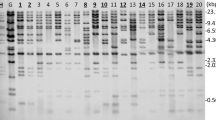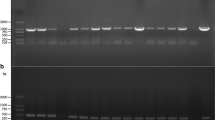Abstract
To analyze the genetics of host-specific toxin production and its relation to the specific pathogenicity of a mitosporic fungus Alternaria alternata, we developed a protoplast fusion system. Protoplasts of drug-resistant transformants of the A. alternata tomato pathotype (AAL-toxin producer) and A. alternata strawberry pathotype (AF-toxin producer) were fused by electrofusion. Of five fusion strains examined, two strains were pathogenic on both tomato and strawberry host plants, whereas the rest of the fusion strains were pathogenic only on tomato. Pulsed-field gel electrophoresis analysis demonstrated that the hybrid strains pathogenic on both tomato and strawberry carry 1.0- and 1.05-Mb conditionally dispensable (CD) chromosomes derived, respectively, from the parental strains of the tomato and strawberry pathotypes. On the other hand, the fusion strains appeared to maintain only a single homologous chromosome derived from one of the parental strain in the case of essential chromosomes (A chromosomes). The results suggest that fusion strains between two different pathotypes of A. alternata might be haploid resulting from the deletion of extra sets of essential chromosomes in the fused nuclei, whereas the CD chromosomes derived from each parental strain could be maintained stably in a new genetic background with an expanded range of pathogenicity.





Similar content being viewed by others
References
Akagi Y, Akamatsu H, Yamamoto M, Tsuge T, Otani H, Kodama M (2005) Characterization of the genomic region, controlling biosynthesis of host-specific AAL-toxins, on the conditionally dispensable chromosome of the tomato pathotype of Alternaria alternata. Fungal Genet Newsl 52:188
Akamatsu H, Itoh Y, Kodama M, Otani H, Kohmoto K (1997) AAL-toxin deficient mutants of Alternaria alternata tomato pathotype by restriction enzyme-mediated integration. Phytopathology 87:967–972
Akamatsu H, Taga M, Kodama M, Johnson R, Otani H, Kohmoto K (1999) Molecular karyotypes for Alternaria plant pathogens known to produce host-specific toxins. Curr Genet 35:647–656
Akamatsu H, Otani H, Kodama M (2003) Characterization of a gene cluster for host-specific AAL-toxin biosynthesis in the tomato pathotype of Alternaria alternata. Fungal Genet Newsl 50(Suppl):355
Arie T, Kaneko I, Yoshida T, Noguchi M, Nomura Y, Yamaguchi I (2000) Mating-type genes from asexual phytopathogenic ascomycetes Fusarium oxysporum and Alternaria alternata. Mol Plant Microbe Interact 13:1330–1339
Covert SF (1998) Supernumerary chromosomes in filamentous fungi. Curr Genet 33:311–319
Garmaroodi HS, Taga M (2007) Duplication of a conditionally dispensable chromosome carrying pea pathogenicity (PEP) gene clusters in Nectria haematococca. Mol Plant Microbe Interact 20:1495–1504
Han Y, Liu X, Benny U, Kistler HC, VanEtten HD (2001) Genes determining pathogenicity to pea are clustered on a supernumerary chromosome in the fungal plant pathogen Nectria haematococca. Plant J 25:305–314
Harimoto Y, Hatta R, Kodama M, Yamamoto M, Otani H, Tsuge T (2007) Expression profiles of genes encoded by the supernumerary chromosome controlling AM-toxin biosynthesis and pathogenicity in the apple pathotype of Alternaria alternata. Mol Plant Microbe Interact 20:1463–1476
Hatta R, Ito K, Hosaki Y, Tanaka T, Tanaka A, Yamamoto M, Akimitsu K, Tsuge T (2002) A conditionally dispensable chromosome controls host-specific pathogenicity in the fungal plant pathogen Alternaria alternata. Genetics 161:59–70
Hatta R, Shinjo A, Ruswandi S, Kitani K, Yamamoto M, Akimitsu K, Tsuge T (2006) DNA transposon fossils present on the conditionally dispensable chromosome controlling AF-toxin biosynthesis and pathogenicity of Alternaria alternata. J Gen Plant Pathol 72:210–219
Ito K, Tanaka T, Hatta R, Yamamoto M, Akimitsu K, Tsuge T (2004) Dissection of the host range of the fungal plant pathogen Alternaria alternata by modification of secondary metabolism. Mol Microbiol 52:399–411
Johnson RD, Johnson L, Itoh Y, Kodama M, Otani H, Kohmoto K (2000) Cloning and characterization of a cyclic peptide synthetase gene from Alternaria alternata apple pathotype whose product is involved in AM-toxin synthesis and pathogenicity. Mol Plant Microbe Interact 13:742–753
Johnson LJ, Johnson RD, Akamatsu H, Salamiah A, Otani H, Kohmoto K, Kodama M (2001) Spontaneous loss of a conditionally dispensable chromosome from the Alternaria alternata apple pathotype leads to loss of toxin production and pathogenicity. Curr Genet 40:65–72
Kistler HC, Meinhardt LW, Benny U (1996) Mutants of Nectria haematococca created by site-directed chromosome breakage are greatly reduced in virulence toward pea. Mol Plant Microbe Interact 9:804–809
Kohmoto K, Otani H, Tsuge T (1995) Alternaria alternata pathogens. In: Kohmoto K, Singh US, Singh RP (eds) Pathogenesis and host specificity in plant diseases: histopathological biochemical, genetic and molecular bases Eukaryotes, vol 2. Pergamon, Oxford, pp 51–63
Maekawa N, Yamamoto M, Nishimura S, Kohmoto K, Kuwata M, Watanabe Y (1984) Studies on host-specific AF-toxins produced by Alternaria alternata strawberry pathotype causing Alternaria black spot of strawberry. 1. Production of host-specific toxins and their biological activity. Ann Phytopathol Soc Jpn 50:600–609
Magnano di San Lio G, Hoeart MJ, Lucas JA, Peberdy JF (1994) Overcoming vegetative incompatibility within and between pathotypes of Pseudocercosporella herpotrichoides by protoplast fusion. Mycol Res 98:653–659
Masunaka A, Tanaka A, Tsuge T, Peever TL, Timmer LW, Yamamoto M, Yamamoto H, Akimitsu K (2000) Distribution and characterization of AKT homologs in the tangerine pathotype of Alternaria alternata. Phytopathology 90:762–768
Masunaka A, Ohtani K, Peever TL, Timmer LW, Tsuge T, Yamamoto M, Yamamoto H, Akimitsu K (2005) An isolate of Alternaria alternata that is pathogenic to both tangerines and rough lemon and produces two host-selective toxins, ACT- and ACR-toxins. Phytopathology 95:241–247
Miao VP, Covert SF, VanEtten HD (1991) A fungal gene for antibiotic resistance on a dispensable (“B”) chromosome. Science 254:1773–1776
Peberdy JF (1989) Presidential address: fungi without coats: protoplasts as tools for mycological research. Mycol Res 93:1–20
Rotem J (1994) The genus Alternaria: biology, epidemiology, and pathogenicity. APS Press, St Paul, MN
Ruswandi S, Kitani K, Akimitsu K, Tsuge T, Shiraishi T, Yamamoto M (2005) Structural analysis of cosmid clone pcAFT-2 carrying AFT10–1 encoding an acyl-CoA dehydrogenase involved in AF-toxin production in the strawberry pathotype of Alternaria alternata. J Gen Plant Pathol 71:107–116
Salamiah, Akamatsu H, Fukumasa-Nakai Y, Otani H, Kodama M (2001a) Construction and genetic analysis of hybrid strains between apple and tomato pathotypes of Alternaria alternata by protoplast fusion. J Gen Plant Pathol 67:97–105
Salamiah, Fukumasa-Nakai Y, Akamatsu H, Otani H, Kohmoto K, Kodama M (2001b) Genetic analysis of pathogenicity and host-specific toxin production of Alternaria alternata tomato pathotype by protoplast fusion. J Gen Plant Pathol 67:7–14
Taga M, Murata M (1994) Visualization of mitotic chromosomes in filamentous fungi by fluorescence staining and fluorescence in situ hybridization. Chromosoma 103:408–413
Taga M, Murata M, Saito H (1998) Comparison of different karyotyping methods in filamentous ascomycetes—a case study of Nectria haematococca. Mycol Res 102:1355–1364
Talbot NJ, Coddington A, Roberts IN, Oliver RP (1988) Diploid construction by protoplast fusion in Fulvia fulva (syn. Cladosporium fulvum): genetic analysis of an imperfect fungal plant pathogen. Curr Genet 14:567–572
Tanaka A, Tsuge T (2000) Structural and functional complexity of the genomic region controlling AK-toxin biosynthesis and pathogenicity in the Japanese pear pathotype of Alternaria alternata. Mol Plant Microbe Interact 13:975–986
Tanaka A, Shiotani H, Yamamoto M, Tsuge T (1999) Insertional mutagenesis and cloning of the genes required for biosynthesis of the host-specific AK-toxin in the Japanese pear pathotype of Alternaria alternata. Mol Plant Microbe Interact 12:691–702
Thomma BPHJ (2003) Alternaria spp.: from general saprophyte to specific parasite. Mol Plant Pathol 4:225–236
Typas MA (1983) Heterokaryon incompatibility and interspecific hybridization between Verticillium albo-atrum and Verticillium dahliae following protoplast fusion and microinjection. J Gen Microbiol 129:3043–3056
Yamagishi D, Akamatsu H, Otani H, Kodama M (2006) Pathological evaluation of host-specific AAL-toxins and fumonisin mycotoxins produced by Alternaria and Fusarium species. J Gen Plant Pathol 72:323–327
Acknowledgments
We are grateful to Richard P. Oliver for providing pAN7-1, and to Junko Kawakami and Yoshinori Miyagawa for technical assistance. This work was supported by a Grant-in-Aid for Scientific Research from the Japanese Society for Promotion of Sciences.
Author information
Authors and Affiliations
Corresponding author
Additional information
The nucleotide sequence data reported are available in the DDBJ/EMBL/GenBank database under the accession numbers AB469331to AB469354.
Rights and permissions
About this article
Cite this article
Akagi, Y., Taga, M., Yamamoto, M. et al. Chromosome constitution of hybrid strains constructed by protoplast fusion between the tomato and strawberry pathotypes of Alternaria alternata . J Gen Plant Pathol 75, 101–109 (2009). https://doi.org/10.1007/s10327-009-0149-1
Received:
Accepted:
Published:
Issue Date:
DOI: https://doi.org/10.1007/s10327-009-0149-1




